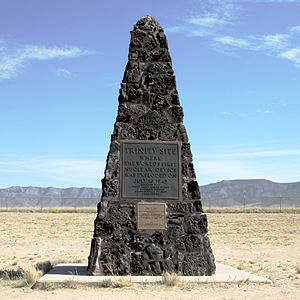Portal:Nuclear technology
The Nuclear Technology Portal
Introduction

- Nuclear technology is technology that involves the nuclear reactions of atomic nuclei. Among the notable nuclear technologies are nuclear reactors, nuclear medicine and nuclear weapons. It is also used, among other things, in smoke detectors and gun sights. (Full article...)
- Nuclear power is the use of nuclear reactions to produce electricity. Nuclear power can be obtained from nuclear fission, nuclear decay and nuclear fusion reactions. Presently, the vast majority of electricity from nuclear power is produced by nuclear fission of uranium and plutonium in nuclear power plants. Nuclear decay processes are used in niche applications such as radioisotope thermoelectric generators in some space probes such as Voyager 2. Generating electricity from fusion power remains the focus of international research. (Full article...)
- A nuclear weapon is an explosive device that derives its destructive force from nuclear reactions, either fission (fission bomb) or a combination of fission and fusion reactions (thermonuclear bomb), producing a nuclear explosion. Both bomb types release large quantities of energy from relatively small amounts of matter. (Full article...)
General images -
Selected article -
The United States and Denmark launched an intensive clean-up and recovery operation, but the secondary stage of one of the nuclear weapons could not be accounted for after the operation was completed. USAF Strategic Air Command "Chrome Dome" operations were discontinued immediately after the accident, which highlighted the safety and political risks of the missions. Safety procedures were reviewed, and more stable explosives were developed for use in nuclear weapons.
In 1995, a political scandal arose in Denmark after a report revealed the government had given tacit permission for nuclear weapons to be located in Greenland, in contravention of Denmark's 1957 nuclear-free zone policy. Workers involved in the clean-up program campaigned for compensation for radiation-related illnesses they experienced in the years after the accident. (Full article...)Selected picture -

The black plaque on top reads:
Trinity Site
Where The World's First Nuclear Device Was Exploded On July 16, 1945
Erected 1965 White Sands Missile Range J. Frederick Thorlin Major General U.S. Army Commanding
The gold plaque below it declares the site a National Historic Landmark, and reads:
Trinity Site has been designated a National Historical Landmark
This Site Possesses National Significance In Commemorating The History of the United States of America
1975 National Park Service United States Department of the Interior
Did you know?
- ... that the sodium fast reactor Fermi 1 suffered a nuclear meltdown that led one operator to suggest "we almost lost Detroit"?
- ... that Project Ketch proposed the detonation of a 24-kiloton nuclear device in Pennsylvania to create a natural-gas storage reservoir?
- ... that the British Tychon missile was developed from a Barnes Wallis concept to keep strike aircraft safe while dropping nuclear bombs?
- ... that plutonium produced in the nuclear reactors at the Hanford Engineer Works was used in the Fat Man bomb used in the atomic bombing of Nagasaki in August 1945?
- ... that under college president Arthur Bronwell in 1959, Worcester Polytechnic Institute built one of the first nuclear research reactors at an American university?
- ... that T. K. Jones thought that a nuclear war was survivable if "there are enough shovels to go around"?
Related WikiProjects
Things you can do
| Parts of this portal (those related to section) need to be updated. Please help update this portal to reflect recent events or newly available information. Relevant discussion may be found on the talk page. (September 2021) |
Selected biography -
Frank Harold Spedding (22 October 1902 – 15 December 1984) was a Canadian-American chemist. He was a renowned expert on rare earth elements, and on extraction of metals from minerals. The uranium extraction process helped make it possible for the Manhattan Project to build the first atomic bombs.
A graduate of the University of Michigan and University of California, Berkeley, Spedding became an assistant professor and head of the department of physical chemistry at Iowa State College in 1937. His efforts at building up the school were so successful that he would spend the rest of his career there, becoming a professor of chemistry in 1941, a professor of physics in 1950, a professor of metallurgy in 1962, and ultimately professor emeritus in 1973. He co-founded, along with Dr. Harley Wilhelm, the Institute for Atomic Research and the Ames Laboratory of the Atomic Energy Commission, and directed the Ames Laboratory from its founding in 1947 until 1968.
Spedding developed an ion-exchange method of separating and purifying rare earth elements using ion-exchange resins, and later used ion exchange to separate isotopes of individual elements, including hundreds of grams of almost pure nitrogen-15. He published over 250 peer-reviewed papers, and held 22 patents in his own name and jointly with others. Some 88 students received their Ph.D. degree under his supervision. (Full article...)
Nuclear technology news
- 14 May 2024 –
- Russia places its nuclear capable submarine-launched Bulava intercontinental ballistic missile into service. (Reuters)
- 9 May 2024 – Joint Comprehensive Plan of Action, Iran–Israel relations
- Iran warns that it will build a nuclear weapon if Israel continues to target its nuclear facilities. (Al Jazeera)
- 25 April 2024 – Russia–NATO relations
- Russian Deputy Foreign Minister Sergei Ryabkov warns that Russia will make NATO nuclear weapons in Poland one of its primary targets if they are deployed there. (The Jerusalem Post)
- 23 April 2024 – North Korea and weapons of mass destruction
- North Korea claims that it tested a new command-and-control system in a simulated nuclear counterstrike. (CNN)
Related portals
Related topics
Subcategories
Associated Wikimedia
The following Wikimedia Foundation sister projects provide more on this subject:
-
Commons
Free media repository -
Wikibooks
Free textbooks and manuals -
Wikidata
Free knowledge base -
Wikinews
Free-content news -
Wikiquote
Collection of quotations -
Wikisource
Free-content library -
Wikiversity
Free learning tools -
Wiktionary
Dictionary and thesaurus






































































































